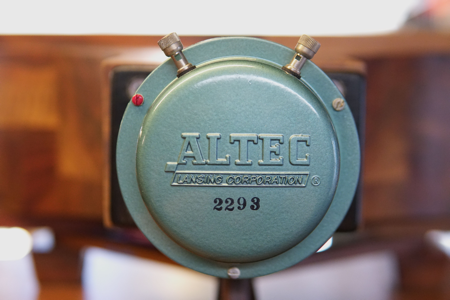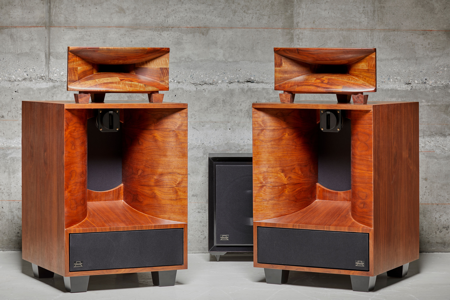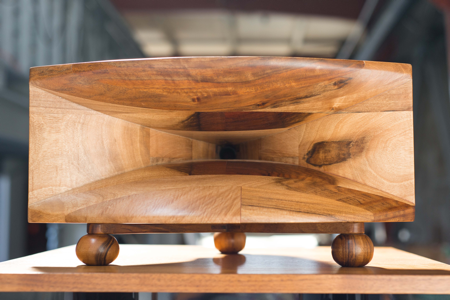
If you are ever at an audio show and you see Burwell & Sons listed in the catalog, I encourage you to look them up. The first thing you should know about them is that they are three of the nicest people I know in audio. I can’t believe it’s been eight years since I met them at the California Audio Show and heard an early pair of their Burwell & Sons Loudspeakers.
The next thing you should know about these guys is that they are not audiophiles. In fact, they are not even close to being audiophiles. They are fun to hang out with and crazy about music and ALTEC and JBL horns and drivers that produce the vintage sound they love. Their ambition in building their speakers is to make this vintage sound available in a smaller, more beautiful work of collectible art. Burwell & Sons builds loudspeakers for connoisseurs who want to appreciate artisan work and vintage speakers in their homes.
Since they started going to audio shows the Burwells have been very open to listening to feedback and learning how to improve their speakers, but not at the expense of losing the vintage Altec sound. Why would they? It’s the sound they love when they listen to the music they love. Their willingness to respond to feedback, however, has led to significant changes, which is why I’m reviewing their speakers again. While they look almost identical to earlier models, these speakers have really improved in almost every area since I first reviewed them in 2014.
I should also mention that these speakers are unlike any other audio product that I know of. They are works of art that should appeal to collectors and connoisseurs of fine, artistic woodwork as much as they appeal to audio enthusiasts. Still, Altec and JBL speakers play such an important part in our audio history that I feel we owe it to their history to listen to this special pair of speakers.
Burwell & Sons Loudspeakers and Vintage Sound
The Burwell & Sons loudspeakers are their interpretation of Altec-Lansing’s Voice of the Theater speaker from days gone by. As I have shared before, one of the first real high fidelity systems I heard was a pair of Altec Voice of the Theater speakers driven by a Marantz tube amplifier and a Garrard 301 turntable. The size of the Burwell loudspeakers, however, is much more room-friendly. They are also more beautiful than the original Voice of the Theater speakers.

The Burwells use only authentic vintage Altec bass drivers and midrange horns that have been reconditioned and restored. They replace the old metal Altec horn with a new and incredibly beautiful, handmade wooden horn. Their wooden horn is built to match the size and flare of the Altec-Lansing 811. Each bass cabinet is also a beautiful example of woodworking art.
It was a big decision to bring these hand-crafted speakers to the audiophile community, and I’m impressed with their willingness to improve the speakers in certain areas. I don’t think there is much chance this father and sons team will mess up the vintage sound as they simply love it too much.
Key Differences from Earlier Models
One of the key ways their latest speakers differ from their early speakers is that they are now three-way with the addition of a JBL slot tweeter. They also now have available a pair of subwoofers and amps for an additional fee. I did not use the subs for this review.

New crossovers inside the bass bins are another difference from earlier models. These crossovers feature pots for adjusting both the midrange horn and tweeter levels. The ability to make these adjustments is a big improvement. Impedance is a nominal 8-ohm load. The sensitivity is in the mid 90 dB range.
Horns and Drivers

The wooden high-frequency horn is a work of art. An artisan carves the horn from reclaimed wood chosen for each project. Gordon says the horn can be created from a wide variety of woods. They currently have a selection of different varieties of walnut that was reclaimed from California’s central valley in the ’80s and ’90s. It takes 104 pieces of wood to build the horn. The artisan that builds the horns hand selects each piece for the most beautiful swaths of grain. The wood finishes look great without being overly glossy. I find them to be very pleasing to the eye. The final product is stunning in a ’50s modern sort of way combined with such beautiful woodwork.
The bass horn is 22 inches wide by 22 inches deep and 28 inches tall sitting on 4-inch footers. So the top of the box is 32 inches tall. With the horn on its stand, they come to 41 inches at the tallest point. The driver of the bass horn is a 15-inch Altec-Lansing 803A with alnico magnets. The wooden high-frequency horn utilizes an 804A compression driver that also uses alnico magnets. My review sample had the famous original Altec green paint on the compression driver!
Review System and Setup
I used my review system for the entire time that I listened to the new Burwell & Sons speakers. These speakers seemed to love the power of my Butler Audio MONAD 100 monoblocks, and I loved the sound.
The controls for adjusting the midrange driver are a convenient addition from earlier models. They really made speaker placement much easier. For me, this meant I could place the speakers just a few inches from the side walls and less than a foot from the rear wall. Toed in so that they pointed at my shoulders, the speakers needed about six inches from the rear wall on the inset and about 10 inches on the side closest to the side wall.
Recorded Music and the Burwell & Sons Speakers
Three phrases sum up the new Burwell & Sons speakers. The first phrase is a big tone, the second is a great scale, and the third is an alive sound.
Nothing says big tone like the massive alnico magnets. Sonny Rollins’ saxophone sounded so juicy I could almost feel the spit. The sound of Ray Brown’s bass had a beautiful rich tone to it that I seldom hear from modern speakers. I could go on and on talking about different instruments. Instead, it is enough to say that every instrument had a beautiful and faithful tone. As a result, these recorded instruments moved me emotionally more like listening to live music.
When I talk about scale, I’m talking about the ability of an audio system to realistically and accurately reveal the size and power of instruments, vocals, trios, big bands, orchestras, and other musical ensembles. Most big panel speakers are outstanding when it comes to conveying the scale of an orchestra or big band. However, very few speakers are successful at conveying the sound of a real acoustic guitar. Likewise, mini-monitors can be great at conveying small-scale and solo instruments. However, I have never heard of a mini-monitor at any price that can realistically convey the scale of a full orchestra or big band. The Burwell speakers can do both.
Does It Sound Alive?
What makes a system sound alive? Well all of the above, but let me add a few more criteria for sounding alive. These are areas where many speakers miss the mark.
- Clarity – the speakers must not sound like they have a blanket thrown over them.
- Effort- the speakers must not sound like they are working hard to get the sound out.
- Dynamics – the speakers must be able to produce dynamics. This is key.
- Bass – the speakers must produce bass that carries the rhythm of the music.
- Top-end – the speakers must have a top-end that gives breath and air without sounding bright or edgy.
The three-way Burwell speakers excel in these five areas, and they are a significant improvement over their earlier two-way design. Adding the tweeter and the pots that allow you to adjust the mid-range and the top end simply brings these speakers to life.
Conclusion
So, these speakers will run you $80,000+, a bit more if you want the subs. This price may be a little rich for your blood, but remember these are not just speakers. They are artisan-crafted works of art that also produce wonderful sound.


hello.do burnwell& sons have a website?thank you.